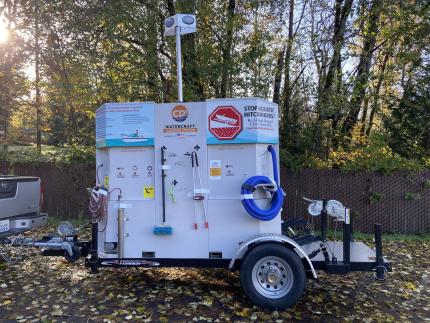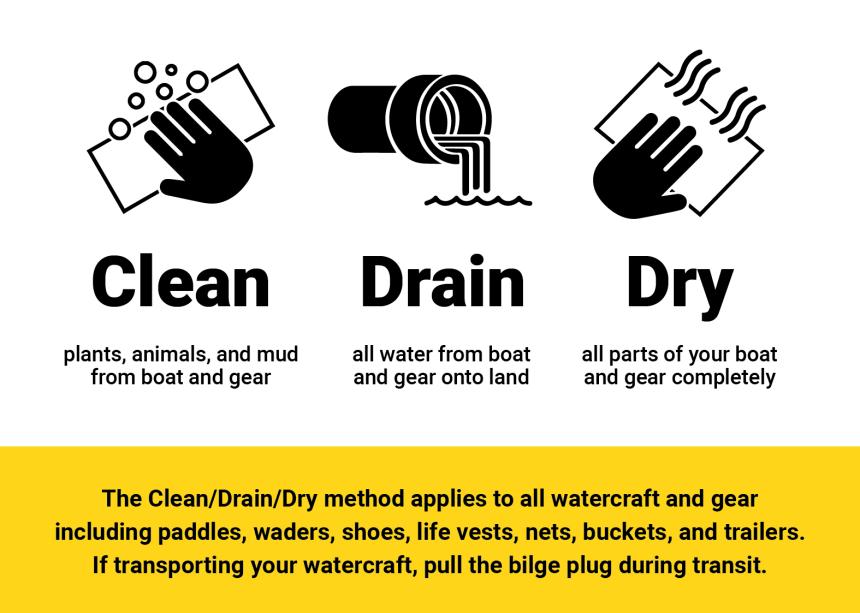Aquatic invasive species (AIS) represent a huge threat to the state's native ecosystems, but there are a number of ways the hazard to Washington's waters can be fought.
Below are tips for the public, or download our printable brochure (PDF).
WDFW's detailed Invasive Species Management Protocols are available in this report (PDF).

Ways to prevent the spread of AIS
Boaters, kayakers, anglers and anyone who recreates or works in Washington's waters should take measures to prevent the spread of aquatic invasive species. There are two methods recommended: the basic "Clean/Drain/Dry," and the more rigorous "decontamination" protocol for known or suspected infested waters.
Boaters and anglers should contact the Washington Department of Fish and Wildlife (WDFW) if they suspect their boats or gear have been used in waters of states infested with zebra or quagga mussels (see map).
WDFW and the Washington Invasive Species Council have partnered to offer Clean, Drain, Dry, Dispose (CD3) stations at several boat launches in Eastern Washington, as well as a mobile CD3 unit available for events and fishing tournaments.
To learn more or reserve the mobile CD3 unit, please visit this webpage. More information also available in this 2022 blog post and in this printable half-page flier (PDF).
Method one: Clean, Drain, Dry

- Clean equipment that has come into contact with Washington waters by removing all visible native and non-native plants, algae or mud from shoes, waders, life vests, boat hulls and engines, trailers and other gear. Use a stiff-bristled brush to clean equipment.
- Drain any accumulated water from boats or gear – including water used in cleaning – back into the lake, stream, or other waterbody from which it came.
- Rinse all surfaces with potable water.
- Let boats or gear fully dry before using again.
To learn more or reserve the mobile CD3 unit, please visit this webpage. Or get tips and learn more at stopaquatichitchhikers.org!
Method two: Decontaminate
Aquatic invasive species can be difficult to see. Therefore, the Clean, Drain, Dry method isn't always enough and additional decontamination may be necessary.
There are multiple ways the general public can decontaminate boats, footwear and gear.
Drying method
Once gear is fully dry, allow it to remain dry for an additional 48 hours before using again in Washington waters. This technique is not suitable for felt-soled shoes; instead, use one of the other methods described below.
Hot water
Hard non-porous surfaces, such as trailers, engines, and shovels, require 15 seconds of constant exposure to hot water (minimum 140 degrees) by soaking or using a hot-water pressure washer. Porous materials and gear with multiple folds or cavities -- such as boots, waders, or nets --require at least 5 minutes of constant exposure to water heated to 120 degrees Fahrenheit. This method is not recommended for gear made of Gore-tex.
Freeze
Freeze your gear for at least 8 hours at 14 degrees Fahrenheit, or for at least 24 hours at 15-32 degrees Fahrenheit.
Chemical method
Chemical treatments should not be done near a waterbody. Soak gear in undiluted antibacterial Formula 409 for 10 minutes. Rinse thoroughly in a contained area. Rinse water must be disposed of down a sewage drain, not a storm drain. Always follow label instructions before use. This method may cause surface cracking of rubber or loss of water repellence.
At this time, WDFW does not recommend other chemicals (including salt water) as there are no published scientific studies showing effectiveness or potential effects on gear.
Penalties for introducing aquatic invasive species
It is against the law (RCW 77.135.040) to possess, transport or traffic prohibited invasive species or to release non-native species into state waters through intentional or unintentional means. This includes animals and plants hitchhiking on boats or field gear; aquarium or terrarium pets or plants; animals or plants used in research or education; unused live fishing bait; or live seafood purchased from a store.
It is illegal to transport aquatic invasive species from one waterbody to another in the state of Washington. Violators face a maximum penalty of one year in jail and $5,000 in fines.
Under Washington state regulations (WAC 220-640-120), prohibited species may be immediately killed and retained only if the person is certain about species identification and assumes responsibility for correct identification and adherence to state rules and fishing regulations.